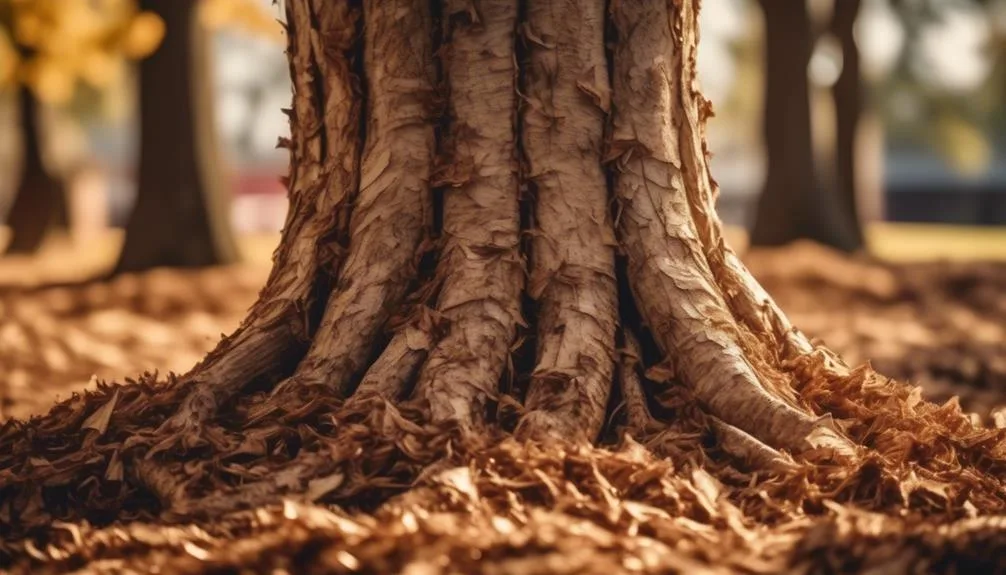Selecting the right mulch for your sycamore trees is crucial for their well-being. Understanding the differences between organic and inorganic mulches, the ideal depth, and specific considerations for sycamore trees is essential.
Let's explore the best mulch options to create a nurturing environment for your sycamore trees to thrive.
Organic Mulches for Sycamore Trees
Consider using organic mulches such as shredded bark or wood chips to help maintain moisture and suppress weeds around your sycamore trees. These mulches offer numerous benefits, including improving soil structure, preventing soil erosion, and regulating soil temperature.
Organic mulches also gradually decompose, adding valuable nutrients to the soil. However, there are some drawbacks to consider. Organic mulches may attract pests, and they require regular replenishment as they decompose.
If you're looking for alternative mulching methods, consider inorganic options such as landscape fabric or gravel. These materials offer long-lasting weed suppression and moisture retention without the need for frequent replacement.
Regardless of the type of mulch you choose, ensuring a proper layer thickness of 2-4 inches will help your sycamore trees thrive.
Inorganic Mulches for Sycamore Trees
Are you looking for a low-maintenance option to help regulate soil moisture and suppress weeds around your sycamore trees? Consider using plastic mulches, a type of synthetic mulch.
Plastic mulches offer several benefits, including effective weed suppression, moisture retention, and heat preservation. They're particularly useful in cooler climates as they can help warm the soil, promoting better root growth and earlier spring growth.
However, it's important to note some disadvantages of synthetic mulches. They're non-biodegradable and can contribute to the accumulation of non-recyclable materials in the environment. Additionally, they may hinder air and water movement into the soil, potentially impacting soil health.
When using plastic mulches, it's essential to monitor soil moisture and provide additional irrigation if necessary to ensure the healthy growth of your sycamore trees.
Best Mulch Depth for Sycamore Trees
If you have opted for plastic mulches around your sycamore trees, determining the best mulch depth is crucial for their healthy growth and maintenance. Mulch benefits for sycamore trees include moisture retention, weed suppression, and insulation from temperature extremes.
When it comes to mulch depth, aim for a thickness of 2-4 inches. This depth provides adequate coverage to retain soil moisture and suppress weed growth while still allowing air and water to penetrate the soil. However, ensure that the mulch isn't piled up against the tree trunk, as this can lead to moisture issues and potential rot.
Maintaining the proper mulch depth is essential for tree health, as it supports the root system and overall vigor of your sycamore trees.
Considerations for Mulching Sycamore Trees
Before mulching your sycamore trees, assess the area for any existing weeds or debris that should be cleared to create a clean surface for the mulch.
When considering mulching for your sycamore trees, there are important factors to keep in mind for the health and well-being of your trees. Here are some considerations to take into account:
- Mulch Types: Choose mulch that allows air and water to penetrate easily. Organic mulches like wood chips or bark are excellent choices as they break down over time, providing nutrients to the soil.
- Tree Health: Ensure that the mulch doesn't touch the trunk of the tree to avoid potential rot or disease. Leave a gap around the base of the tree to promote air circulation and prevent moisture buildup.
These considerations will help you make the best choices for mulching your sycamore trees.
Applying Mulch to Sycamore Trees
After assessing the area for any existing weeds or debris and considering important factors for the health and well-being of your sycamore trees, the next step is to properly apply the chosen mulch.
Start by clearing a 3-4 inch space around the tree's base to prevent mulch from touching the trunk. This helps avoid rot and pest issues.
Then, evenly spread the mulch in a donut shape, leaving a gap near the trunk. This ensures proper air and water circulation. Be sure not to pile the mulch against the tree.
Mulch application offers numerous benefits such as moisture retention, weed suppression, and soil insulation. It also promotes a healthier root system.
Conclusion
Incorporating organic mulches such as wood chips or bark, or inorganic options like stones and gravel, can significantly benefit the health and growth of your sycamore trees. Remember to maintain a 2-4 inch mulch depth, positioned a few inches from the tree trunk, while considering climate and soil conditions.
Proper mulching is key to nurturing your sycamore trees for long-term vitality.
Mark Hoffman is a dedicated arborist and tree care specialist with over a decade of experience. His love for trees began when he visited Yosemite National Park as a teenager and was awestruck by the giant sequoias. Mark pursued his passion by studying forestry at Michigan Technological University, where he earned a Bachelor of Science degree.
Since then, he has worked tirelessly in the field of arboriculture, helping to preserve and protect trees in his community. His expertise and dedication have made him a respected leader in the industry and a valuable resource for anyone seeking advice on tree care.
